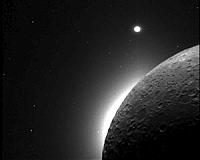 |
Washington DC (SPX) Jun 15, 2010 NASA-funded scientists estimate from recent research that the volume of water molecules locked inside minerals in the moon's interior could exceed the amount of water in the Great Lakes here on Earth. Scientists at the Carnegie Institution's Geophysical Laboratory in Washington, along with other scientists across the nation, determined that the water was likely present very early in the moon's formation history as hot magma started to cool and crystallize. This finding means water is native to the moon. "For over 40 years we thought the moon was dry," said Francis McCubbin of Carnegie and lead author of the report published in Monday's Online Early Edition of the Proceedings of the National Academy of Sciences. "In our study we looked at hydroxyl, a compound with an oxygen atom bound with hydrogen, and apatite, a water-bearing mineral in the assemblage of minerals we examined in two Apollo samples and a lunar meteorite." McCubbin's team utilized tests which detect elements in the parts per billion range. Combining their measurements with models that characterize how the material crystallized as the moon cooled during formation, they found that the minimum water content ranged from 64 parts per billion to 5 parts per million. The result is at least two orders of magnitude greater than previous results from lunar samples that estimated water content of the moon to be less than 1 parts per billion. "In this case, when we talk about water on the moon, we mean water in the structural form hydroxyl," said Jim Green, director of the Planetary Science Division at NASA Headquarters in Washington. "This is a very minor component of the rocks that make up the lunar interior." The origin of the moon is now commonly believed to be the result of a Mars-sized object that impacted the Earth 4.5 billion years ago. This impact put a large amount of material into Earth's orbit that ultimately compacted to form the moon. The lunar magma ocean that is thought to have formed at some point during the compacting process, began to cool. During this cooling, water either escaped or was preserved as hydroxyl molecules in the crystallizing minerals. Previous studies found evidence of water both on the lunar surface and inside the moon by using respectively, remote sensing data from the Indian spacecraft Chandrayaan-1 and other lunar sample analysis. Carnegie researchers looked within crystalline rocks called KREEP (K for potassium; REE, for rare Earth elements; and P for phosphorus). These rocks are a component of some lunar impact melt and basaltic rocks. "Since water is insoluble in the main silicates that crystallized, we believed that it should have concentrated in those rocks," said Andrew Steele of Carnegie and co-author of the report. "That's why we selected KREEP to analyze." The identification of water from multiple types of lunar rocks that display a range of incompatible trace element signatures indicates that water may be at low concentrations but ubiquitous within the moon's interior, potentially as early as the time of lunar formation and magma ocean crystallization. "It is gratifying to see this proof of the hydroxyl contents in lunar apatite," said lunar scientist Bradley Jolliff of Washington University in St. Louis. "The concentrations are very low and, accordingly, they have been until recently nearly impossible to detect. We can now finally begin to consider the implications - and the origin - of water in the interior of the moon." The research was funded by the NASA Astrobiology, Mars Fundamental Research, and the Lunar Advanced Science and Exploration Research programs in NASA's Planetary Division in Washington.
Share This Article With Planet Earth
Related Links Carnegie Institution's Geophysical Laboratory Mars News and Information at MarsDaily.com Lunar Dreams and more
 Model Helps Search For Moon Dust Fountains
Model Helps Search For Moon Dust FountainsGreenbelt MD (SPX) Jun 11, 2010 In exploration, sometimes you find more than what you're looking for, including things that shouldn't be there. As the Apollo 17 astronauts orbited over the night side of the moon, with the sun just beneath the horizon right before orbital "sunrise," Eugene Cernan prepared to make observations of sunlight scattered by the sun's thin outer atmosphere and interplanetary dust from comets and collis ... read more |
|
| The content herein, unless otherwise known to be public domain, are Copyright 1995-2010 - SpaceDaily. AFP and UPI Wire Stories are copyright Agence France-Presse and United Press International. ESA Portal Reports are copyright European Space Agency. All NASA sourced material is public domain. Additional copyrights may apply in whole or part to other bona fide parties. Advertising does not imply endorsement,agreement or approval of any opinions, statements or information provided by SpaceDaily on any Web page published or hosted by SpaceDaily. Privacy Statement |